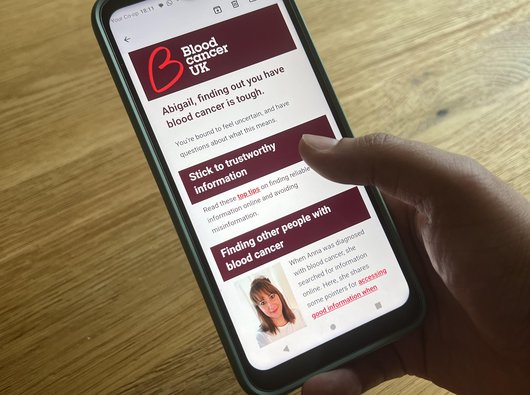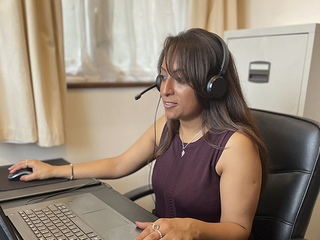Blood cancer tests
If your doctor thinks you might have blood cancer, they'll arrange some tests to help make a diagnosis. On this page we explain some of the common tests you might have.
What are the tests for?
Having these tests does not necessarily mean you have blood cancer. Many of these tests are used to diagnose a range of health conditions.
If you do have blood cancer, these tests can help find out which specific type of blood cancer you have, such as leukaemia, lymphoma, myeloma, MDS or MPN. You may continue to have these tests before, during and after your treatment, to see how you’re doing.
Having tests can be worrying. If you have any questions, or just need someone to talk to, contact our Support Services Team.
If you've been told you have blood cancer
Sign up our weekly support email for people recently diagnosed.
It gives you clear and simple information, practical tips and advice from others with blood cancer, to help during the first few weeks and months after diagnosis.

Blood tests
Most blood tests are carried out at your GP surgery or local hospital. Blood will be taken from your vein using a thin needle and syringe. It might hurt a bit as the needle goes in, but it's usually over quite quickly. Your blood will then be sent to a laboratory to be tested. Your doctor should tell you when you will get the results.
Your doctor may request these checks on your blood:
Full blood count (FBC)
This measures the number of each type of cell in your blood: red blood cells, white blood cells and platelets. Find out more about normal levels in a full blood count.
Liver function tests
Blood tests called liver function tests (LFTs) can check how well your liver is working.
Urea and electrolytes
This test checks how well your kidneys are working.
Other blood tests
If you are starting treatment for blood cancer you may have an infection screening or virology testing. This is to check for conditions such as HIV, hepatitis B and hepatitis C.
You may also have a peripheral blood film. This looks at your red blood cells, white blood cells and platelets to see whether they are the right size and shape, and whether they look healthy.
Blood tests can also be used to do immunophenotyping and some genetic testing - see below.
Bone marrow biopsy
This is also called a bone marrow test, bone marrow aspirate or bone marrow examination.
Bone marrow is a spongy tissue found inside some of your bones. It is where your body makes blood cells.
A bone marrow biopsy involves removing a sample of bone marrow to look at under the microscope. This can show whether your body is making normal, healthy blood cells or not.
How is a bone marrow biopsy done?
The bone marrow sample will normally be taken from your hip bone. You’ll lie on your side with your knees tucked up to your chest. The doctor or nurse will give you an injection to numb the area (local anaesthetic).
The doctor will then use a large needle (aspirate) to suck out a sample of bone marrow from your hip bone. A piece of bone may also be taken using an instrument called a trephine.
A bone marrow biopsy can be done on the ward or in the outpatient department. It takes about 20 to 30 minutes, but removing the bone marrow sample only takes a few minutes.
You can usually go home the same day if you're feeling well enough. You’ll have a bandage over the area, which you should keep on for 24 hours.
If you’re having sedation, you’ll need someone with you to take you home and stay with you overnight.
A bone marrow biopsy is a common procedure and any risks are small. There is a small risk of damage to the area near where the biopsy is being done, but this is very rare.
Is a bone marrow biopsy painful?
Having a bone marrow biopsy can be painful, but it seems to vary – some people say they don’t feel much, some experience a pulling sensation, and others find it painful.
You will be given a local anaesthetic to numb the area. You might also be offered a tablet to make you feel sleepy (a sedative), or gas and air to help with the pain.
If you are nervous about the test, speak to your healthcare team in advance. You may want someone to come with you too.
After the test, your hip might hurt for a few days, and you may need some painkillers to take at home. The soreness should settle within a few days.
"I’ve had two bone marrow biopsies. The teams doing them were very helpful and caring, explained everything that was going on and minimised any pain as much as possible."
Tony, living with blood cancer since 2020.

Bone marrow biopsy results
You won’t get your results straight away. It can take one or two weeks to get them, and you’ll usually have a follow-up appointment.
Waiting for test results can be a worrying time. If you have any questions, or just need someone to talk to, contact our Support Services Team.
Lymph node biopsy
A lymph node biopsy is when your doctor removes all or part of a lymph node during a short operation. Lymph nodes are glands that are part of your lymphatic system.
Removing a lymph node and looking at it under a microscope can show whether there are any abnormal blood cells present.
How is a lymph node biopsy done?
You usually have a lymph node biopsy as an outpatient, which means you don’t have to stay in hospital overnight.
You will either have an injection to numb the area (local anaesthetic) or you will be asleep for it (general anaesthetic), depending on where the lymph node is.
The doctor will make a small cut in the skin and remove all or part of your lymph node. The procedure may take up to half an hour. The doctor will then close the cut with some stitches, and probably cover it with a small bandage.
Your nurse will tell you how to look after the wound over the next few days. For a few days after any biopsy, you may feel sore and bruised around the area. Taking mild painkillers can help. The bruising will go away in a couple of weeks. Your healthcare team will tell you who to contact if you have any problems after your test.
You will usually get the results within two weeks.
Waiting for test results can be a worrying time. If you have any questions, or just need someone to talk to, contact our Support Services Team.
Scans
Scans can be used to look at organs and bones inside the body. There are different types of scans that your doctor may arrange.
CT scan
A CT scan uses x-rays and computers to create detailed picture of the inside of your body.
You usually have a CT scan in the x-ray (radiology) department as an outpatient. You may be given a drink or injection of a dye, which allows parts of your body to be seen more clearly. This may make you feel hot all over for a few minutes.
During the scan, you'll usually lie on your back on a flat bed that moves into the CT scanner. A scan normally takes 10 to 30 minutes and is painless. During the scan, you will have to stay still.
MRI scan
An MRI scan uses magnetic fields and radio waves to produce detailed images of the inside of the body.
You lie on your back on a couch that moves into the MRI machine. You might have an injection of a dye to help show your body’s organs more clearly on the scan. The scan is painless but you need to lie still, which may be a bit uncomfortable.
The scan usually takes between 15 minutes and an hour. The scanner is very noisy and you will be given earplugs or headphones. It may be possible to listen to music during the scan.
PET scan
A PET scan is similar to an MRI scan. It uses low-dose radiation to check the activity of cells in different parts of the body. It may be used to give more detailed information about cancer or abnormal areas seen on other scans.
Before the scan, you’ll have an injection of a substance called a ‘radiotracer’. You'll need to wait quietly for about an hour to give it time to be absorbed by the cells in your body. During this time, you’ll need to avoid moving or speaking much.
During the scan, you lie on a flat bed that's moved into the centre of the scanner. The scan usually takes up to 30 minutes and is painless, although you need to lie still.
X-rays
An x-ray is a test that uses small doses of radiation to take pictures of the inside of your body, especially your bones. Having an x-ray is not painful and only takes a few minutes. All x-rays expose the body to some radiation, however the risks of this are very small compared to the benefit of having the x-ray.
Ultrasound scans
An ultrasound scan, sometimes called a sonogram, uses high-frequency sound waves to create an image of part of the inside of the body.
A small handheld device will be moved over the part of your body being scanned. It shouldn't be painful or uncomfortable.
Genetic tests
There are various methods for looking at genes in cancer cells. Depending on the method used, you may hear genetic tests described as genetic testing, cytogenetics, cytogenetic testing, molecular genetics, molecular testing, karyotyping or FISH tests.
Every kind of cancer, including blood cancer, is caused by changes (faults) in the DNA within cells. DNA is arranged in sections called genes, which are contained in structures called chromosomes inside a cell.
These gene changes that cause blood cancer happen during a person’s lifetime – they are not faulty genes that you can pass down to children.
Using a sample of cancer cells, doctors can look for particular changes in the genes and chromosomes, to help them identify the specific type of blood cancer. Knowing if you have particular gene changes in your cancer cells can also help predict what treatments might work best for you, and give a clearer idea of prognosis.
Genetic tests are usually done on cells collected from a blood test or a bone marrow biopsy (see above).
Immunophenotyping
Immunophenotyping (sometimes called flow cytometry) means looking at the proteins on the surface of cells. It’s used to see if there are any abnormal blood cells, and if so, how many.
Immunophenotyping can help diagnose some blood cancers, help specify the exact type of blood cancer, and give a clearer idea of prognosis.
Immunophenotyping is normally done on cells collected from a blood test or bone marrow biopsy.
The test is very sensitive – even if there is only a small number of abnormal cells, the test will see them.

Worried about anything or have questions?
If you need someone to talk to, please don't hesitate to contact our Support Service by phone or email.
